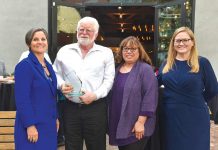Now that Thanksgiving Day is past and we’ll be dining on
leftover turkey for the next few days, I want to tell you about one
thing I’m truly thankful for this holiday weekend. I wish to
express my genuine gratitude for Archaeopteryx.
Now that Thanksgiving Day is past and we’ll be dining on leftover turkey for the next few days, I want to tell you about one thing I’m truly thankful for this holiday weekend. I wish to express my genuine gratitude for Archaeopteryx.
In case you’re uncertain what exactly I’m referring to, Archaeopteryx (pronounced AH-kee-OP-tuh-rix) is the original dino-bird. Without this now extinct creature, you’d never have enjoyed that leg of roasted turkey Thursday at your family get-together. In fact, our South Valley region might be sorely lacking in all avian life if this dinosaur had never existed on earth during the Late Jurassic period more than 65 million years ago.
It astonishes me to consider how all of the world’s birds are direct descendants of a dinosaur. From the tiny hummingbirds that zip around our garden flowers, to the hawks and buzzards that glide high over our region’s hills, to the chickens, ducks and geese on our farms, all our fine feathered friend evolved from Archaeopteryx.
The dinosaur I’m referring to definitely wasn’t what people usually imagine these ancient creatures to be, such as towering beasts like T-Rex. Archaeopteryx was about the size of our modern-day crow. Its wings were arranged in the same pattern as feathers on today’s birds.
The dinosaur’s feathers were also shaped like the flight feathers of today’s birds, leading scientists to assume Archaeopteryx was able to perform powered flight in short bursts. It most likely ate bugs it caught in flight or found in trees.
The discovery of the first Archaeopteryx skeleton in a Bavarian quarry in 1861 is possibly history’s most important fossil find. It came only two years after Charles Darwin published “On the Origin of Species,” his revolutionary – and provocative – book introducing the world to evolution.
One argument given against evolution was the perceived lack of “intermediate animals” found among the fossils. Darwin’s critics suggested if life on earth changed from one form to another over the epochs, then there must exist fossils showing the structure of species in-between the differing organisms.
Archaeopteryx proves to be such an intermediate stepping stone, evolutionists insist, affirming Darwin’s notion by demonstrating a clear combination of bird and dinosaur features. Thus, the discovery of Archaeopteryx played a crucial role in evolution’s acceptance as a mainstream theory of science.
Since Darwin’s day, a total of seven Archaeopteryx skeletons have been unearthed in Bavaria. The fine detail of the animal’s delicate and hollow bones and feathers were fossilized in very fine-grained limestone called lithographic limestone.
Today, there are more than 10,000 species of birds on our planet. We’re lucky to live in a location where such a wide variety of them make their home or pass through in their annual migration. Most notably lately, you might have witnessed the V-shaped squadrons of geese daily flying over us.
On occasions, I’ve hiked through South Valley’s Henry Coe State Park and have witnessed wild turkeys peering suspiciously at me through tall grass. With only their heads and necks in sight, they seem like the treacherous raptors in the “Jurassic Park” movies. The bird-dinosaur connection seems obvious to me during these close encounters.
Of course, I’m well aware that the view birds evolved from dinosaurs can be extremely controversial for some folks. That’s why Darwin waited 19 years before presenting his daring idea. He knew the notion of natural selection would outrage some, and evolution continues to provoke controversy.
Many fundamentalists maintain without doubt that God instantly created birds – either on the fifth day (as described in Genesis 1:20-23) or the sixth day (as implied in Genesis 2:19). They insist natural selection was never part of the Creator’s recipe.
The conflict between science and religion has risen in the news lately, most notably with various public school authorities attempting to introduce into biology classes the concept of “intelligent design.”
The question of evolution versus intelligent design has huge political, social and economic ramifications affecting our lives here in the South Valley and elsewhere. The debate affects how science will be taught to future generations.
We’ve gone down this road before centuries ago. During the Renaissance, the Roman Catholic Church feared the scientific theory that the Earth orbited the Sun.
Church authorities worried a helio-centric paradigm might cause believers to doubt biblical authority – and thus threaten their own power built on biblical interpretation. In reaction, they burned “heretical” scholars and intimidated Galileo.
Scientific research, however, never weakened the Roman Catholic Church. And you might say the faith is even stronger today with one billion believers. The Vatican eventually granted Galileo an apology.
Whether you believe in evolution or creationism – or in intelligent design or that extraterrestrial beings planted the seeds of life on earth – take some time this weekend to enjoy the beauty of the birds inhabiting our South Valley’s great outdoors. Be truly thankful we live in a world with such wondrous animals.
As for me, when I bite into my turkey sandwich, I’ll consider the fact I might very well be eating a dinosaur’s descendent. Pass the cranberry sauce.













